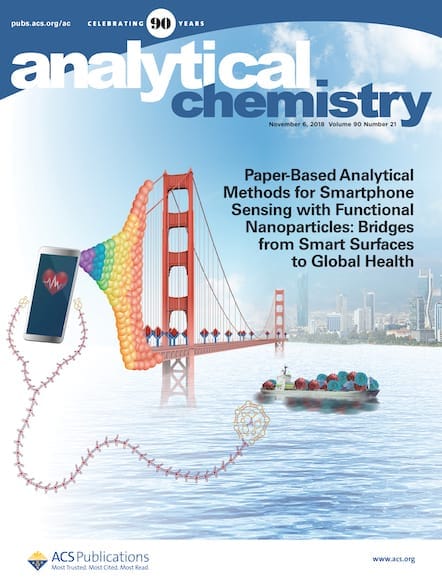Professor Robbyn K. Anand, an Assistant Professor in the Department of Chemistry at Iowa State University, is the recipient of the 2021 Analytical Chemistry Young Innovator Award. Co-sponsored by Analytical Chemistry and Chemical and Biological Microsystems Society (CBMS), this annual award honors early-career researchers who demonstrate exceptional technical advancement and innovation in the field of […]

Co-sponsored by Analytical Chemistry and Chemical and Biological Microsystems Society (CBMS), this annual award honors early-career researchers who demonstrate exceptional technical advancement and innovation in the field of microfluidics or nanofluidics. Professor Anand will receive an award plaque and an honorarium of US $2,500.
“I feel deeply honored because I respect and admire the leaders who have established this field. I am also immensely proud of my students, who impress me daily with their dedication and ingenuity. I view this recognition as a call to train the next generation of innovators in microfluidics and nanofluidics,” says Professor Anand.
Get to Know Professor Anand
Professor Anand’s research integrates electrochemical sensing, electrokinetic focusing, and cellular dielectrophoresis with microfluidics to address critical needs in human health. The goal of her research is to broaden access to diagnostic information at the point of need, thereby allowing physicians to provide more timely and better tailored therapeutic interventions, ultimately improving outcomes for patients.
Professor Anand joined the Department of Chemistry at Iowa State University as an Assistant Professor in August 2015. She was introduced to microfluidics by Professor Richard M. Crooks at the University of Texas at Austin during her doctoral work, which focused on the development of electrochemical methods to generate electric field gradients that drive enrichment and separation of trace analytes. As a postdoctoral fellow at the University of Washington, she worked with Professor Daniel T. Chiu to advance methods for the isolation of circulating tumor cells.
Over the last several years, her group has developed microfluidic platforms for ‘liquid biopsy’ to aid in cancer diagnosis and to inform treatment decisions. One such technology facilitates selective and individual isolation of circulating tumor cells from peripheral blood, thereby allowing for the identification of cell-to-cell differences that drive cancer progression and response to therapy. Another device electrokinetically enriches circulating cell-free nucleic acids and facilitates subsequent label-free electrochemical detection of targeted sequences. These platforms have been designed to minimize the need for peripheral equipment and manual intervention by the operator.
“Our approach to these diagnostic challenges is to span our efforts from fundamental advancements to clinical application, which creates opportunities for broad impact. For example, in response to the recent global crisis, we have adapted the new approach that we developed for circulating tumor DNA detection for sensitive and low-cost quantification of viral RNA. Advancing science while addressing real-world problems is highly rewarding,” says Professor Anand.
Read an Interview with Professor Anand:
I caught up with Professor Anand recently to learn more about her research and what’s next for her and her research group. I’ve provided highlights from our conversation below.
What advice would you give to upcoming researchers in the field?
Think of yourself broadly as a scientist and avoid defining yourself too narrowly. There is a lot of room for innovation at the interfaces between distinct STEM fields, and many current challenges require a multidisciplinary approach to be solved effectively. Therefore, an ability to communicate, collaborate and innovate across these boundaries will maximize your potential for impact.
Do you have an ACS paper that you would like to share? Why did you choose this one?
Here is a paper that we published in the Journal of the American Chemical Society. As a result of this work, we fundamentally advanced droplet biotechnology by creating a path to perform functions on preformed droplets that were previously inaccessible. The methods that we developed can be leveraged for controlled delivery of reagents and the enrichment and separation of droplet components. We are excited about the potential for cross-cutting impact in areas ranging from single-entity bioassays to droplet-templated particle synthesis.
Concentration Enrichment, Separation, and Cation Exchange in Nanoliter-Scale Water-in-Oil Droplets
J. Am. Chem. Soc. 2020 142 (6), 3196-3204.
DOI: 10.1021/jacs.9b13268
How will your work benefit society?
The pandemic has underscored the importance of detailed and timely diagnostic information, which allows patients and physicians to make better informed decisions about what action to take. This crisis has also increased the awareness of the global community about limitations in access to diagnostics with respect to the speed, cost, sensitivity, shelf-life, and need for specialized equipment. The platforms that we develop, whether for viral or cancer diagnostics, address these barriers to reduce delays and inequities in healthcare.
What’s next in your research?
We are both moving towards translation by vetting the platforms we have developed clinically, for example, in the diagnosis and monitoring of melanoma, and working to understand fundamental aspects of these systems more deeply so that we can continue to innovate. Collaborations with my colleagues in chemistry and engineering here at Iowa State as well as the Holden Comprehensive Cancer Center at the University Iowa are essential to those efforts.
Why do you choose to publish in Analytical Chemistry?
I publish in Analytical Chemistry because of its long-standing and consistent record of excellence and the opportunity to connect with a readership at the forefront of measurement science.
Is there anything else that you would like to share?
I would like to take this opportunity to thank Analytical Chemistry for supporting early career scientists like myself and to impress upon the readers the importance of mentorship. My journey as a scientist began because I happened upon a poster advertising a National Science Foundation Research Experience for Undergraduates (NSF-REU), which led me to work for a summer in 2002 with Professor James A. Cox at Miami University of Ohio. The impact that this research experience had on my scientific career has taught me how valuable it is to invest our time and resources in young scientists.
